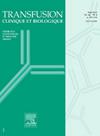Harnessing the potential of blood donors negative for high prevalence Rh antigens: A database initiative for thalassaemia care
IF 1.2
4区 医学
Q4 HEMATOLOGY
引用次数: 0
Abstract
Background and objectives
With increasing life expectancy and prevalence of thalassaemia, it has led to a greater need for safe blood, yet the current supply from voluntary donors is insufficient to meet this demand. Thalassaemia recipients face a significant risk of alloimmunization because of repeated exposure to foreign red cell antigens. Study aims to determine high prevalent Rh antigen negative donors in western India donor population along with what percentage of these donors are willing to become dedicated voluntary donors for thalassaemia patients. Study also aims to examine factors influencing their willingness and challenges faced in mobilizing dedicated donors.
Method
700 whole blood donors from western India, following screening for inclusion & exclusion criteria as per Drugs and Cosmetic Act (DCA) 2020 amendment guidelines & were sero-negative for transfusion transmitted infections were enrolled for the study. Red cell phenotyping was performed using Conventional Tube Technique (CTT) for “D”, “C”, “E”, “c”, “e” and “K” antigen using known antisera. Donors that were “C” AND/OR “e” antigen negative were contacted telephonically and were counseled and motivated for becoming voluntary blood donors. Statistical analysis assessed correlation between donation frequency, donor’s occupation and education.
Result
Among 700 donors, 96.6% (n = 676) were males and 3.4% (n = 24) were females. The most predominant blood group was B > O > A > AB. Rh(D) antigen was present in 91.44% (n = 640) and absent in 8.6% (n = 60). Prevalence of other Rh antigens is as follows: “e” (99%) > “C” (85.4%) > “c” (59.1%) > “E” (18.0%). Only 1.15% had “K” antigen positive. The commonest Rh phenotype R1R1 (DCe/DCe) was expressed by 40.57% (n = 283), and the least common r″r (cE/ce), r″r″ (cE/cE) and r′r′ (Ce/Ce) was found in 0.14% (n = 1), respectively. ‘C’ negative, ‘e’ negative, ‘C’ and ‘e’ antigen negative donors constituted 14.8% (n = 104) with 93.2% (n = 97) C-antigen negative, 1.92% (n = 2) e-antigen negative and 4.8% (n = 5) both “C” and “e” antigen negative donors. The commonest phenotypes among C-antigen and e-antigen negative donors were rr (50%) and RzR2 (1.94%) respectively. Likewise, the most common phenotype amongst both C- and e-antigens negative donors was R2R2 (3.84%). 61.5% of the donors agreed to enroll for voluntary blood donation following telephonic invitation, while 6.8% of them refused permanently. Approximately, 3.9% of the blood donors were willing to donate blood only when needed and 27.8% of them could not be contacted.
Conclusion
Creating a database of voluntary donors with known phenotype, especially who lack very common antigens like “C” and “e” and are willing to become dedicated, regular voluntary donors for thalassemic patients can ensure timely administration of safe blood. One of the major challenges for this noble initiative was lack of awareness which can be circumvent effectively with proper counseling efforts.
利用高流行率 Rh 抗原阴性献血者的潜力:地中海贫血护理数据库倡议。
背景和目标:随着预期寿命的延长和地中海贫血症发病率的增加,对安全血液的需求也随之增加,但目前来自自愿捐献者的血液供应不足以满足这一需求。由于反复接触外来红细胞抗原,地中海贫血受血者面临着巨大的同种免疫风险。研究旨在确定印度西部捐献者人群中 Rh 抗原阴性捐献者的高流行率,以及这些捐献者中愿意成为地中海贫血患者专用自愿捐献者的比例。研究还旨在探讨影响其意愿的因素以及在动员自愿捐献者时所面临的挑战:研究招募了 700 名来自印度西部的全血捐献者,根据《药品和化妆品法案》(DCA)2020 年修订指南的纳入和排除标准进行筛查,他们的输血传播感染血清阴性。红细胞表型分析采用传统试管技术(CTT),使用已知抗血清检测 "D"、"C"、"E"、"c"、"e "和 "K "抗原。通过电话联系了 "C "和/或 "e "抗原阴性的献血者,并向他们提供咨询,鼓励他们成为自愿献血者。统计分析评估了献血频率、献血者职业和教育程度之间的相关性:在 700 名献血者中,96.6%(n=676)为男性,3.4%(n=24)为女性。最主要的血型是 B > O > A > AB。91.44%(640 人)存在 Rh(D)抗原,8.6%(60 人)不存在。其他 Rh 抗原的流行情况如下:e"(99%)>"C"(85.4%)>"c"(59.1%)>"E"(18.0%)。只有 1.15%的人 "K "抗原呈阳性。最常见的 Rh 表型 R1R1(DCe/DCe)占 40.57%(样本数=283),最不常见的 r "r(cE/ce)、r''r''(cE/cE)和 r'r'(Ce/Ce)分别占 0.14%(样本数=1)。C "阴性、"e "阴性、"C "和 "e "抗原阴性供体占 14.8%(n=104),其中 93.2%(n=97)C 抗原阴性,1.92%(n=2)e 抗原阴性,4.8%(n=5)"C "和 "e "抗原均阴性。C抗原和e抗原阴性供体中最常见的表型分别是rr(50%)和RzR2(1.94%)。同样,在 C 抗原和 e 抗原阴性的捐献者中,最常见的表型是 R2R2(3.84%)。61.5%的献血者在接到电话邀请后同意自愿献血,6.8%的献血者永久拒绝献血。约有 3.9% 的献血者只愿意在需要时献血,27.8% 的献血者无法联系上:结论:建立一个已知表型的自愿献血者数据库,尤其是那些缺乏 "C "和 "e "等常见抗原并愿意成为地中海贫血患者的忠实、定期自愿献血者的人,可以确保及时提供安全的血液。这一崇高举措面临的主要挑战之一是缺乏认识,而通过适当的咨询工作可以有效地解决这一问题。
本文章由计算机程序翻译,如有差异,请以英文原文为准。
求助全文
约1分钟内获得全文
求助全文
来源期刊
CiteScore
2.50
自引率
11.80%
发文量
234
审稿时长
36 days
期刊介绍:
Transfusion Clinique et Biologique, the official journal of the French Society of Blood Transfusion (SFTS):
- an aid to training, at a European level
- the only French journal indexed in the hematology and immunology sections of Current Contents
Transfusion Clinique et Biologique spans fundamental research and everyday practice, with articles coming from both sides. Articles, reviews, case reports, letters to the editor and editorials are published in 4 editions a year, in French or in English, covering all scientific and medical aspects of transfusion: immunology, hematology, infectious diseases, genetics, molecular biology, etc. And finally, a convivial cross-disciplinary section on training and information offers practical updates.
Readership:
"Transfusers" are many and various: anesthetists, biologists, hematologists, and blood-bank, ICU and mobile emergency specialists...

 求助内容:
求助内容: 应助结果提醒方式:
应助结果提醒方式:


